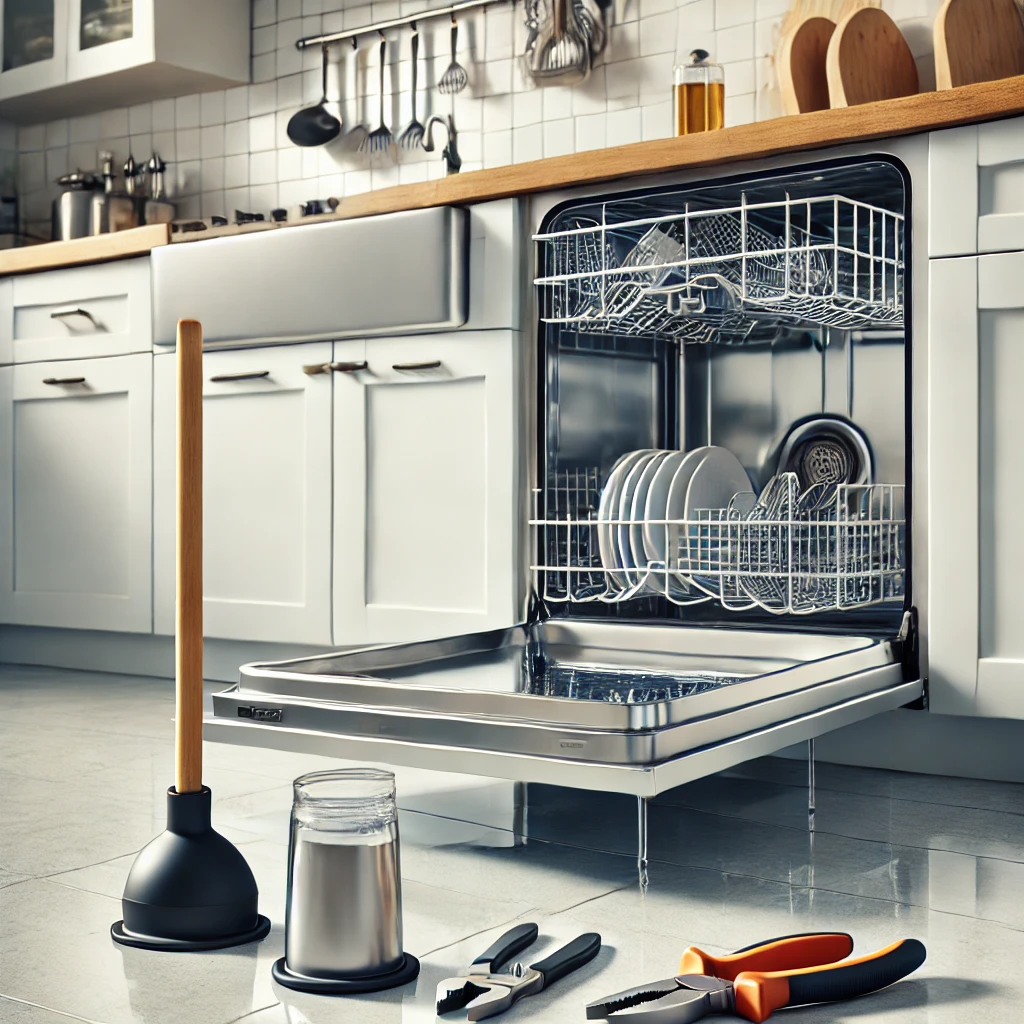
What to Do When Dishwasher Won't Drain Water
A dishwasher that won’t drain can leave your kitchen in a mess and your dishes sitting in a pool of dirty water. Fortunately, many drainage problems can be resolved without the need for professional repairs. Here’s a step-by-step guide to troubleshooting and fixing a dishwasher that won’t drain.
1. Turn Off the Power
Before starting any troubleshooting, always ensure your safety by disconnecting the dishwasher from the power supply.
- Unplug the Dishwasher: If your dishwasher is plugged into an outlet, simply unplug it.
- Switch Off the Circuit Breaker: For hardwired dishwashers, turn off the circuit breaker that powers the appliance.
Tip: Never work on electrical appliances while they are connected to power.
2. Check for a Clogged Filter
The dishwasher filter traps food particles and debris, preventing them from clogging the drain. If the filter is dirty or blocked, water may not drain properly.
How to Clean the Filter:
- Locate the Filter: The filter is typically at the bottom of the dishwasher under the spray arm.
- Remove the Filter: Twist or pull it out (check your user manual for specific instructions).
- Clean the Filter: Rinse it under warm water and scrub gently with a brush to remove grease and debris.
- Reinstall the Filter: Place it back in its position and ensure it’s securely fitted.
Tip: Clean the filter regularly to prevent drainage issues.
3. Inspect the Drain Hose
The drain hose carries water from the dishwasher to the sink or garbage disposal. If it’s kinked, clogged, or improperly connected, it can prevent water from draining.
How to Check the Drain Hose:
- Disconnect the Hose: Use a wrench to loosen the clamp and carefully remove the hose.
- Check for Kinks: Straighten any bends or kinks in the hose.
- Clear Blockages: Use a long, flexible brush or run water through the hose to clear clogs.
- Reconnect the Hose: Reattach the hose securely and ensure it’s positioned correctly.
Tip: Avoid sharp bends in the hose to maintain proper water flow.
4. Examine the Garbage Disposal Connection
If your dishwasher drains into the garbage disposal, blockages in the disposal or a missing knockout plug could cause drainage problems.
How to Check the Garbage Disposal:
- Clear Blockages: Run the garbage disposal to ensure it’s free of clogs.
- Check the Knockout Plug: If the dishwasher is newly installed, make sure the knockout plug in the disposal inlet has been removed. Use a screwdriver and hammer to gently knock it out if it’s still in place.
Tip: Always run your garbage disposal before starting the dishwasher to clear debris that might block the drain.
5. Inspect the Drain Pump
The drain pump pushes water out of the dishwasher. If it’s clogged or malfunctioning, the dishwasher won’t drain properly.
How to Check the Drain Pump:
- Access the Pump: Remove the bottom panel of the dishwasher to locate the drain pump.
- Check for Debris: Inspect the pump impeller for food particles or objects like glass or bones.
- Test the Pump: If the pump doesn’t seem to be working, use a multimeter to check for electrical continuity. If it’s faulty, the pump may need replacement.
Tip: Avoid overloading the dishwasher to prevent debris from reaching the pump.
6. Clean the Air Gap
The air gap, located near the sink, prevents back flow into the dishwasher. If it’s clogged, water may not drain properly.
How to Clean the Air Gap:
- Remove the Cap: Unscrew or pull off the air gap cap.
- Clean Inside: Use a bottle brush or a pipe cleaner to remove debris inside the air gap.
- Rinse Thoroughly: Run water through the air gap to flush out any blockages.
Tip: Regular cleaning of the air gap ensures smooth water drainage.
7. Test the Dishwasher’s Float Switch
The float switch monitors the water level inside the dishwasher. If it’s stuck or faulty, it may prevent the dishwasher from draining.
How to Check the Float Switch:
- Locate the Float: The float is usually a small dome-shaped device on the bottom of the dishwasher.
- Test Movement: Gently lift the float and let it drop. It should move freely and click when it engages the switch.
- Clean the Float: If it’s stuck, clean it with warm water and a soft cloth to remove any debris.
- Test the Switch: Use a multimeter to check for continuity. If it’s defective, replace it.
Tip: Keep the float switch clean to avoid false readings.
8. Run a Diagnostic Cycle
Many modern dishwashers have a diagnostic mode that can help identify drainage issues.
How to Run Diagnostics:
- Refer to the Manual: Check your dishwasher’s user manual for instructions on activating diagnostic mode.
- Monitor the Results: Pay attention to any error codes or indicators that point to a specific problem.
Tip: If the dishwasher displays an error code, consult the manual or manufacturer’s website for guidance on resolving it.
9. Call a Professional
If you’ve tried all the steps above and your dishwasher still won’t drain, it’s time to consult a professional technician. They can inspect the appliance for more complex issues, such as electrical faults or internal damage.
When to Call a Professional:
- Persistent Problems: If the problem persists despite troubleshooting.
- Complex Repairs: Issues with the control board or wiring require expert handling.
Tip: Regular maintenance and timely repairs can extend the life of your dishwasher.
Conclusion
A dishwasher that won’t drain is a common issue, but with the right steps, you can often resolve it yourself. Start by checking for blockages in the filter, hose, or air gap, and inspect components like the drain pump and float switch. Regular maintenance can prevent drainage problems and keep your dishwasher running smoothly. If all else fails, don’t hesitate to call a professional for help.

